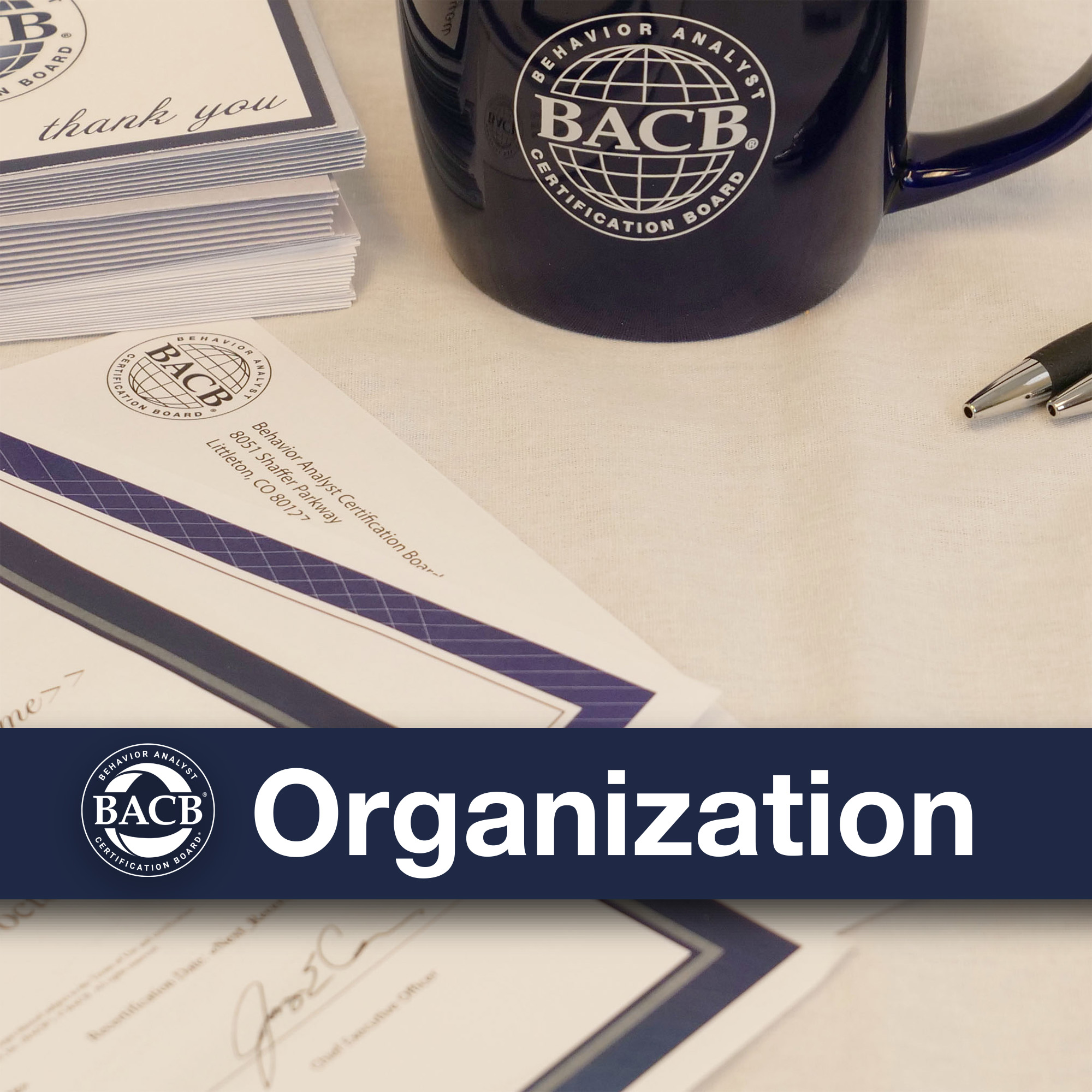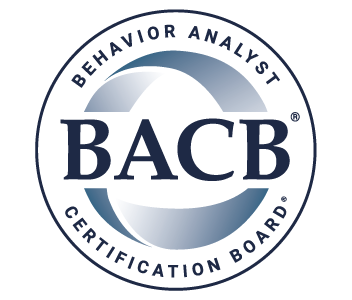Browse our new Public Resources tab for web pages tailored to consumers of behavior-analytic services, their support systems, and employers of behavior analysts. Check it out and share it with your clients today.
Tag: BACB
How to Represent Your BACB Certification Status

What’s in a name? When it comes to representing your certification status, the answer is everything.
At some point, you’ve heard us say “Be sure to properly represent your BACB certification status.” But what does that mean? What’s the “proper” way to do it? That’s what we plan to answer in this blog, but here’s the gist of it:
When you refer to your BACB certification, you must refer to its status—whether active, inactive, or somewhere in between—accurately.
It might surprise you how often this comes up in day-to-day life. You refer to your certification status when chatting with friends about your current studies or career. It’s mentioned when you work with peers, clients, parents/guardians, and employers in classrooms and clinical settings. You write it on your resume, job applications, and billing authorizations. It even crops up when you’re training, supervising, or giving lectures.

So, here’s another question for you, one that has echoed through school halls and study rooms for centuries: Why does this matter? The truth is that misrepresentation can have real-life consequences, even if done accidentally. In just a minute, we’ll outline how to accurately represent your certification status, but first, we need to discuss why it’s so important:
- Protecting consumers: Imagine that you’re an RBT applicant. You completed your 40-hour training, studied the materials, and scheduled your exam. Believing that you’ll soon pass, you put that you’re an “RBT Pending Examination” on your resume, and you get a job. Now you’re working with a client one-on-one, but you’re not certified. What if you don’t pass the exam? Uh oh. This is just one example of how misrepresentation can open a can of worms that’s potentially dangerous for you, your employer, and most importantly, your client.
- Adhering to BACB ethics requirements: As you know, all BACB applicants and certificants are bound by a code of ethics. These codes mandate that behavior analysts and technicians represent themselves accurately, and a violation could put your eligibility or certification at risk. For the details, check out what standard 2.08 of the Ethics Code for Behavior Analysts and standard 3.07 of the RBT Ethics Code (2.0) have to say about misrepresentation.
- Protecting the value of your certification: All BACB certification marks are registered with the United States Patent and Trademark Office (among other jurisdictions), and it’s crucial that they’re used correctly. As we mentioned in the July 2021 BACB Newsletter, if we fail to enforce our trademark rights, they could be jeopardized, and BACB certifications could lose their value. For specifics, check out the Guidelines for Use of BACB Intellectual Property.
How-To Guide
In this section, we’ll outline the dos and don’ts of representing your certification status. These guidelines are airtight to avoid any possible confusion, as confused clients and employers are not informed clients and employers. We hope that these examples make your life a little bit easier:
| Status | Guidelines |
|---|---|
| Active Certification |
As a reminder, you don’t need to use the registered trademark symbol when referring to your own certification (e.g., RBT®). |
| Applicant |
|
| Inactive Certification (e.g., on voluntary inactive status, no supervisor) |
As a reminder, those on voluntary inactive status and those who hold an RBT or BCaBA certification but do not have a qualified supervisor on record with the BACB must indicate that their certification is inactive if they need to refer to their certification. For more information, check out the Inactive Policy in the RBT, BCaBA, or BCBA Handbook. |
Bonus Tips

- Don’t say that the BACB licensed you: It’s important to note that there’s a difference between the BACB, which is a credentialing organization, and a licensure board. The BACB provides certifications, not licenses. If you practice in the US and want to learn more, visit the US Licensure of Behavior Analysts web page.
- Don’t say that the BACB is your employer: Please don’t represent yourself as a BACB employee, as it’s a violation of our Terms of Use. We see this most frequently on social media platforms like LinkedIn. Instead, list your certification in LinkedIn’s License or Certification section.
- Don’t modify BACB trademarks: In the past, we’ve seen some funny takes on BACB certification marks, such as “BCBA-CS” for “BCBA consulting supervisor.” While we must give points for creativity, BACB trademarks aren’t a choose your own adventure. Please only use them as intended: RBT, BCaBA, BCBA, and BCBA-D.
How to Address Misrepresentation

Now that you know what to do and why, let’s talk about misrepresentation in the real world: What should you do if you see someone misrepresenting their certification status? What if that person is you?
The first step is to gently correct if possible. If the issue persists, the second step is to report it to all relevant entities (e.g., BACB, licensure board).
You Misrepresented Your Status
Let’s say that while reading this blog, you realized that you’ve been misrepresenting your certification status. Don’t panic! If you can, fix the error. Change your social media bio, revise your resume, contact the website’s administrator, shout your true certification status from the mountain tops—whatever you need to do. If you can’t fix the error yourself, tell your supervisor (if you have one), document your attempts to correct it, and self-report to the BACB through the Ethics Self-Reporting Form. Don’t forget to include your documentation in the submission.
Someone Else Misrepresented Their Status
If you notice that someone else is misrepresenting their certification status, follow the same procedure. First, give them an opportunity to fix the error. Here’s one way to begin that conversation:

“I hope you’re doing well. I just checked out your social media profile, and I’m so excited to see that you’re in a behavior analysis program. I’m not sure if you’re aware, but you can’t represent yourself as a BCBA (or a BCBA in training) until you’ve passed the exam, as it might be confusing. The BACB has clear guidelines on what’s acceptable. Can I share some resources with you, or could we hop on a call to chat about it?”
You don’t have to repeat this word-for-word, but it’s a good start.
If you aren’t comfortable reaching out to this person, or if they fail to fix the error, please report them to the BACB through the Reporting Infringement or Misuse Form. We’ll take it from there.
In summary, to represent your certification status properly, you should follow our guidelines and be as clear as possible when communicating with others. Taking misrepresentation seriously benefits your clients, your employer, and you. If you see misrepresentation in the wild, please take all appropriate steps to address it.
Thank you for taking the time to read this blog post. Your willingness to learn more about these topics helps uphold the integrity your certification. If you have any questions or concerns, please get in touch through the Contact Us Form.
Reporting Alleged Ethics Violations Based on Publicly Available Documentation
Reporting Alleged Ethics Violations Based on Publicly Available Documentation
By the BACB
This video explores the Publicly Documented Alleged Violation reporting option. Please watch to learn about reporting requirements and considerations, the submission process, and more. Visit our Reporting Alleged Violations Based on Publicly Available Documentation web page for additional information.
You can find all of the BACB’s videos on our YouTube channel.
BACB Data and Developments in 2020
The BACB is pleased to share BACB Data and Developments in 2020, a new video with an accompanying infographic. This video recaps 2020 at the BACB, touching on important changes, milestones, and data points. Check it out to see just how much the practice of ABA is growing. And don’t forget to view the infographic for a concise summary of last year’s most important data points.
Happy New Year, and thank you for your dedication to ABA!
BACB Data and Developments in 2020
BACB Data and Developments in 2020
By the BACB
The BACB is pleased to share BACB Data and Developments in 2020, a new video with an accompanying infographic. This video recaps 2020 at the BACB, touching on important changes, milestones, and data points. Check it out to see just how much the practice of ABA is growing. And don’t forget to view the infographic for a concise summary of last year’s most important data points.
You can find all of the BACB’s videos on our YouTube channel.
Check out this infographic for a brief overview of the BACB’s data and developments in 2020.
Verifying BACB Credentials
Verifying BACB Credentials
By the BACB
This video outlines the purpose of the BACB Certificant Registry and offers guidance on how to use it. Please watch at your convenience.
You can find all of the BACB’s videos on our BACB Videos web page or our YouTube channel.
5 BACB Resources You May Not Know About
Note: The information in this blog may be outdated.

Finding a specific piece of information online isn't always the easiest task. And sometimes you aren't even sure what you're looking for until you find it.
Whether you're already certified as a behavior analyst or researching your career options, the BACB website can be a valuable resource. But you may not have discovered these five time–saving gems yet.
Knowing the Numbers
When you're considering a career in behavior analysis, it's important to look at the big picture. Understanding the growth curves for RBTs, BCaBAs, and BCBAs can give you the confidence and insight to make informed choices about which certification is appropriate for you to pursue.
That's why the BACB publishes certificant trends on its Certificant Data page. You can quickly find answers to these questions:
- How many people hold certification at each level?
Our graphs show current and historical data that can help you evaluate the number of new professionals that the BACB certifies each year. - How fast is each certification program growing?
These same graphs tell a story about the growth trajectory of each certification program. For example, by looking at the data, you can see that the number of certified RBTs has grown from 328 when it was introduced in 2014 to 71,875 in 2020. That enormous jump shows a fast–growing demand for credentialed RBTs. (Check out the Certificant Data page to see stats for BCaBAs and BCBAs.)
Staying Informed About Ethics
Understanding ethics requirements is a vital part of the profession of behavior analysis. That's why the BACB is scaling up the resources on its Ethics page.
You may already be familiar with the Ethics Code for Behavior Analysts, which outlines what behavior analysts must do—and must not do—to best protect clients and others. The Code provides guidance on many ethics–related situations you may encounter as a behavior–analytic practitioner, such as:
- avoiding conflicts of interest.
- maintaining confidentiality.
- using contracts and fees.
- implementing behavior–change programs.
- acting as a supervisor.
But there's much more to the BACB ethics resources than the Code documents. You'll also want to check out the following important sources of support for navigating ethics dilemmas.
Ethics Resources
In this section, you can access:
- Ethics–Related Newsletters
The BACB newsletter has delivered critical content to applicants and certificants since 2004. Under Ethics Resources, we've listed and linked to every newsletter that includes ethics information. - Ethics–Related Journals and Books
Our behavior analysis ethics bibliography will save you time and legwork. - Common Code Violations
Knowing about the common ethics violations is invaluable when supervising activities and for understanding policies within organizations. You'll find the most common ethics violations for 2018 and 2016–17 under Ethics Resources.
Reporting to the Ethics Department
If you need support in deciding whether to report a violation, you'll find what you need in this section, including:
- what you should know about submitting a Notice of Alleged Violation.
- how to submit ethics forms.
- the timeline for each step of reporting alleged violations.
- how to self–report.
Code–Enforcement Procedures
To learn about the steps that the BACB can take against someone's exam eligibility or certification, take a look at this section. The Code–Enforcement Procedures is your go–to resource, but you'll also see information about the types of and possible outcomes for disciplinary sanctions.
Ethics touches every aspect of a behavior analyst's professional life. The BACB's extensive ethics resources will help you obtain and maintain your certification so that you can continue changing lives.
Finding Your Behavior Analysis Subspecialty
The profession of behavior analysis is known primarily for its success in treating individuals with autism spectrum disorder and developmental disabilities. However, behavior analysis also offers opportunities in a variety of other subspecialties. Staying aware and knowledgeable about these other areas as the profession grows is a good strategy for anyone researching a career in behavior analysis.
An RBT, BCaBA, or BCBA might work with a variety of clients, including:
- patients in mental health clinics.
- children or adults with developmental disabilities.
- children and teenagers in school settings.
- older populations in their homes or in care facilities.
- organizations that need guidance with safety, leadership, or performance.
To learn more about areas that would interest you, the BACB has published a library of informative videos and fact sheets focusing on a wide range of behavior analysis subspecialties.
Each BACB video features a subject matter expert who shares details about working in the subspecialty, such as problems a behavior analyst might treat and the science behind those methods. For example, if you like the idea of helping to improve performance in the workplace, you can learn about organizational behavior management (OBM) from Dr. John Austin, a leading expert in the field. He shares how research has shaped the industry and allowed OBM practitioners to empower employees and leaders for success.
If you want to see a snapshot of each subspecialty and associated sub–areas with resources and recommended reading, check out our handy Subspecialties Areas document.
Staying in the Know
We know that waiting is one of the hardest parts of obtaining certification, especially when submitting applications or other electronic documents. That's why our Customer Service team shares daily updates about processing times on the BACB website. Our team processes materials in the order they are received, so you can be sure we'll get to yours as soon as possible.
For example, if you submitted your renewal application electronically on May 20th, you can check the Customer Service page regularly to see if we're processing materials received on that date yet.
In addition to processing times, you'll see instructions for system errors or notifications related to your BACB account.
Still haven't found what you need? The Customer Service page also includes links to frequently accessed resources for each certification, such as renewals, requirements, and applications.
Taking Advantage of the Data
The BACB Resources page provides a wealth of information about job demand, BACB activities, past ethics violations, and much more. Here's what you'll find:
- Employment demand for behavior analysts
When you're researching a career in behavior analysis, it can be helpful to investigate state–specific data. The BACB provides two reports showing demand for behavior analysts from 2010 to 2019 and from 2012 to 2014 by state. - Ethics violations data
While the BACB Ethics page is the go–to source for ethics requirements and violations, you'll find unique information on the BACB Resources page. A Summary of Ethics Violations and Code–Enforcement Activities: 2016–2017 tells you what kinds of code-enforcement activities occurred during the two years after the Ethics Code was released. - BACB–authored publications
Check out numerous journal articles related to the profession of behavior analysis, including history, requirements, training, education, and much more.
Finding the right links, documents, and data doesn't have to be an accident. Bookmark these indispensable BACB resources to stay in the know and save time.
The BACB: What It Is, What It Does, and Why

It doesn’t matter if you have been a BACB certificant for many years, are newly certified, or are just starting to explore becoming a practitioner of behavior analysis—it is likely that you have a number of questions about the landscape of the applied behavior analysis (ABA) profession. This is where the importance of understanding the role of the BACB in the profession comes in.
The BACB was established in 1998 to meet the credentialing needs of ABA practitioners, governments, and consumers of ABA services. In the BACB’s early years, its certification programs grew consistently but slowly. In its first 13 years, the BACB certified 10,000 individuals. In the last several years, this number has grown to more than 120,000 certificants! In addition, since 2009, 34 states have passed laws to license behavior analysts. These developments mean that professional certification and the credentialing of ABA practitioners are relatively recent events, about which many people have questions. These include: What is the BACB’s role? What is credentialing and why is it important? Why can’t the BACB speak for behavior analysis? To get a better understanding of how it all works, read on for answers to these common questions.
What Is The BACB?
The Behavior Analyst Certification Board (BACB) is:
- A nonprofit organization – The BACB was founded in Florida as a nonprofit corporation in 1998 and has 501(c)(3) tax–exempt status from the IRS. Both of these legal and regulatory frameworks place important limits on BACB activity.
- A credentialing organization – The primary function of the BACB is to operate certification programs, similar to a regulatory entity. In this role, the BACB provides practice requirements, ethics codes, and Code-Enforcement Procedures that are designed to protect consumers, applicants, and certificants, among other certification–program activities. In this capacity, ABA practitioners must interact with the BACB regularly to maintain their certification.
What Is Credentialing and Why Is It Important?
As mentioned earlier, the BACB’s certification programs exist as a regulatory–like mechanism to protect consumers of behavior–analytic services. To protect consumers, the BACB establishes entry–level eligibility standards for education and training AND provides a mechanism to address behavior analysis practitioners who violate BACB ethics code(s).
Professional Credentialing
Credentialing is vital to the profession of behavior analysis because of the particularly vulnerable populations that a majority of behavior analysis practitioners serve. Without credentialing, how would we know who is qualified to enter the profession and who isn’t?
Two of the many differences between private certification and government–issued licensure are highlighted in the following text boxes because these are the two primary ways behavior analysts are credentialed to practice.
Private Certification (BACB)
- Voluntary
- Code enforcement is limited to those certified by the BACB or applying for BACB certification, and consequences may be imposed on an individual’s certification or their ability to apply.
Licensure (34 states)
- Mandatory
- Disciplinary enforcement may be enacted upon anyone practicing, with or without a license, and consequences include substantial fines and possible incarceration.
In the ABA profession, practitioners who obtain certification by the BACB have a great deal of mobility because their certification will meet licensure requirements in almost any state with licensure for the practice of behavior analysis. For more information about US state licensure, please refer to the BACB’s US Licensure of Behavior Analysts web page or visit APBA’s Licensure and Other Regulation of ABA Practitioners web page.
NCCA Accreditation and Consumer Protection
All three of the BACB’s current certification programs are accredited by the National Commission for Certifying Agencies (NCCA). The BACB must adhere to NCCA–established accreditation processes, similar to the way BACB certificants and applicants must meet BACB requirements.
Using the NCCA accreditation processes, the BACB convenes groups of subject matter experts (SMEs) to evaluate and potentially revise requirements for each BACB credential. SME recommendations are then voted on by the BACB Board of Directors before they are adopted. Through this process, the requirements change as needed to ensure greater consumer protection through standards that accurately reflect the ever–evolving practice of behavior analysis. As usual, everything comes back to consumer protection.
For anyone interested in a little more reading about the processes that are used by the BACB to develop standards and examinations, they are outlined in a number of publications that can be found on our BACB Resources web page. In addition, you can give us feedback if you have suggestions for SMEs to consider when they revise requirements by submitting a Certification Program Requirements: Request for Change form.
What Is the BACB’s Role in The ABA Profession?
The major professional organizations in ABA have very specific missions and roles and substantial limitations on their activities from various sources. These limitations include state laws where the organization was founded as a nonprofit, IRS rules, and for the BACB, our NCCA accreditation requirements. Let’s start with the role of the BACB.
To recap, the BACB’s job is to credential practitioners of behavior analysis and to coordinate with regulatory authorities. Although we are sometimes called upon to engage in advocacy and political and social commentary, our involvement in these activities is necessarily restricted by some of the entities mentioned earlier. In our regulatory–like role, the BACB is prohibited from engaging in political activity and has very strict limitations on its acceptable activities. That said, a number of the questions we receive indicate that some think of the BACB as a professional membership association, with flexibility about our public behavior. Although we sometimes wish we could engage in a broader array of advocacy activities, we have a very limited role in ABA—again, due to restrictions imposed upon us by certain legal statutes and IRS rules. It’s useful to think about the BACB as similar to a licensure board since we serve a similar and often interrelated regulatory function. It is notable to mention here that other professions may have certification boards that look like the BACB in function but are regulated differently under law and IRS rules, which allows them greater flexibility than the BACB. We know that this makes understanding our limitations pretty tricky!
A professional membership association is charged with representing the interests of its members and speaking on behalf of a profession. The BACB doesn’t have members; we have certificants. Fortunately, ABA has a number of state, provincial, and national professional associations to serve the membership role.
Two major professional membership associations in behavior analysis are the Association of Professional Behavior Analysts (APBA) and the Association for Behavior Analysis International (ABAI). These organizations were established to provide different services than a certification board and are permitted much more flexibility in their permissible activities, including making public statements and taking a stand on social issues. We strongly encourage our certificants to become members in their state and national professional associations if they have not already. In fact, at the very beginning of a certificant’s professional experience, we send a welcome letter encouraging them to join and become involved in their relevant professional associations. The professional membership associations are permitted to engage in a wide range of important activities. They are truly the voice of behavior analysis and have the primary obligation to represent our profession. Together, membership associations, the BACB, and, most importantly, behavior analysis practitioners and stakeholders can work to improve the discipline of behavior analysis.
We hope that this information answers some of your questions about what the BACB does and why. If you’re interested in hearing more about this topic, check out our podcast episode, The BACB’s Role in the Profession of Behavior Analysis.


 Represent yourself in the following ways:
Represent yourself in the following ways: Do not represent yourself in the following ways:
Do not represent yourself in the following ways: